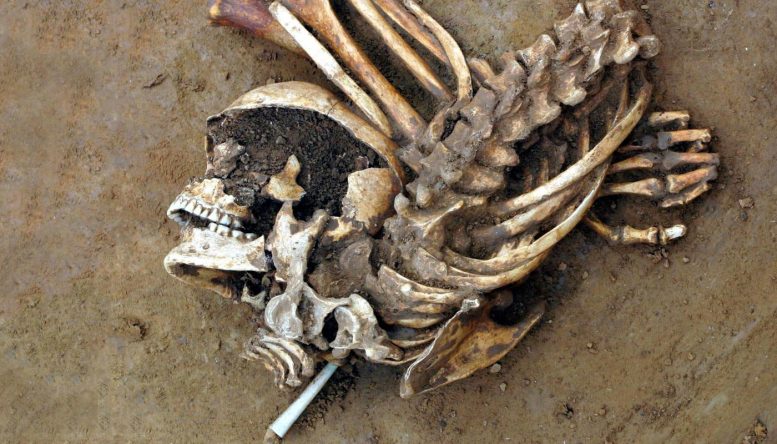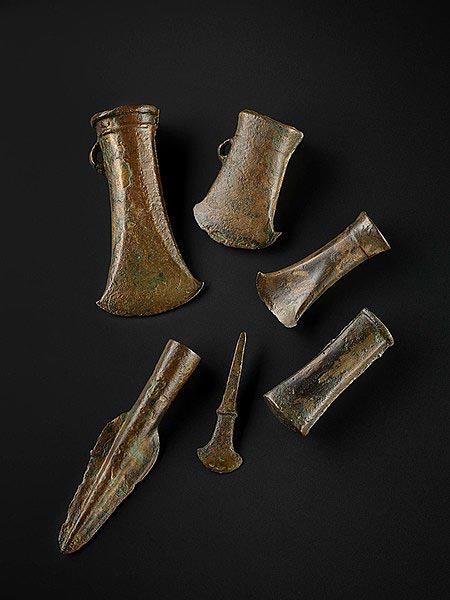
A photograph of the skeleton of one of the four individuals who we have sequenced who we think is likely to have participated in the migration we detect into southern Britain and to have displaced half the ancestry of the local population. This skeleton was excavated from the site of Cliffs End Farm in Kent. Credit: Wessex Archaeology
A major new study of ancient DNA has traced the movement of people into southern Britain during the Bronze Age.
A major new study of ancient DNA has traced the movement of people into southern Britain during the Bronze Age.
In the largest such analysis published to date, scientists examined the DNA of nearly 800 ancient individuals
The new study, led by the University of York, Harvard Medical School, and the University of Vienna, shows that people moving into southern Britain around 1300‒800 BC were responsible for around half the genetic ancestry of subsequent populations.

A major new study of ancient DNA has traced the movement of people into southern Britain during the Bronze Age.
A major new study of ancient DNA has traced the movement of people into southern Britain during the Bronze Age.
In the largest such analysis published to date, scientists examined the DNA of nearly 800 ancient individuals
The new study, led by the University of York, Harvard Medical School, and the University of Vienna, shows that people moving into southern Britain around 1300‒800 BC were responsible for around half the genetic ancestry of subsequent populations.

This image is of bronze age tools from the National Museums of Scotland, which could give readers a sense of the material culture associated with people who lived at the time of the migration. Credit: Bronze Age tools curated the National Museums of Scotland
The combined DNA and archaeological evidence suggests that, rather than a violent invasion or a single migratory event, the genetic structure of the population changed through sustained contacts between mainland Britain and Europe over several centuries, such as the movement of traders, intermarriage, and small scale movements of family groups.
The study finds evidence that the new migrants became thoroughly mixed in to the Southern British population in the period 1000‒875 BC.
The researchers say the origin of these migrants cannot yet be established with certainty, but they are most likely to have come from communities in and around present-day France.
The Middle to Late Bronze Age was a time when settled farming communities expanded across the landscapes of southern Britain, and extensive trade routes developed to allow the movement of metal ores for the production of bronze.
These new networks linked wide-ranging regions across Europe, as seen from the spread of bronze objects and raw materials.
The study’s lead archaeologist Professor Ian Armit, from the University of York, said: ‘We have long suspected, based on patterns of trade and shared ideologies, that the Middle to Late Bronze Age was a time of intense contacts between communities in Britain and Europe. READ MORE...
The combined DNA and archaeological evidence suggests that, rather than a violent invasion or a single migratory event, the genetic structure of the population changed through sustained contacts between mainland Britain and Europe over several centuries, such as the movement of traders, intermarriage, and small scale movements of family groups.
The study finds evidence that the new migrants became thoroughly mixed in to the Southern British population in the period 1000‒875 BC.
The researchers say the origin of these migrants cannot yet be established with certainty, but they are most likely to have come from communities in and around present-day France.
The Middle to Late Bronze Age was a time when settled farming communities expanded across the landscapes of southern Britain, and extensive trade routes developed to allow the movement of metal ores for the production of bronze.
These new networks linked wide-ranging regions across Europe, as seen from the spread of bronze objects and raw materials.
The study’s lead archaeologist Professor Ian Armit, from the University of York, said: ‘We have long suspected, based on patterns of trade and shared ideologies, that the Middle to Late Bronze Age was a time of intense contacts between communities in Britain and Europe. READ MORE...